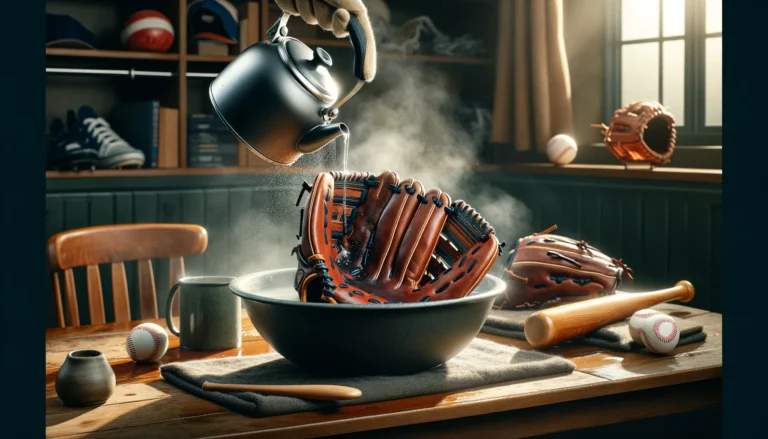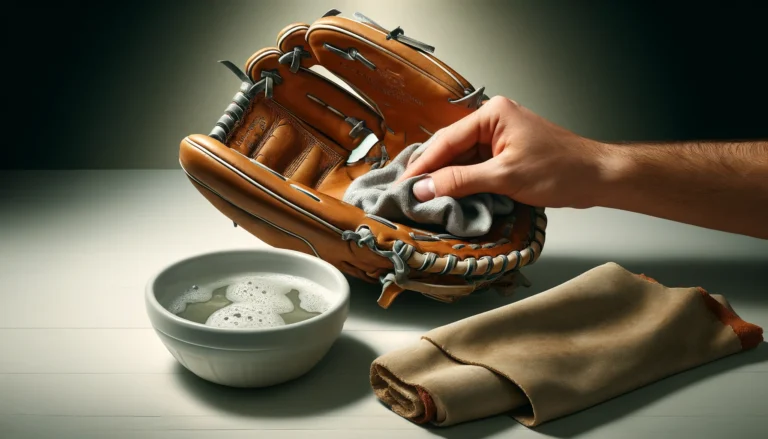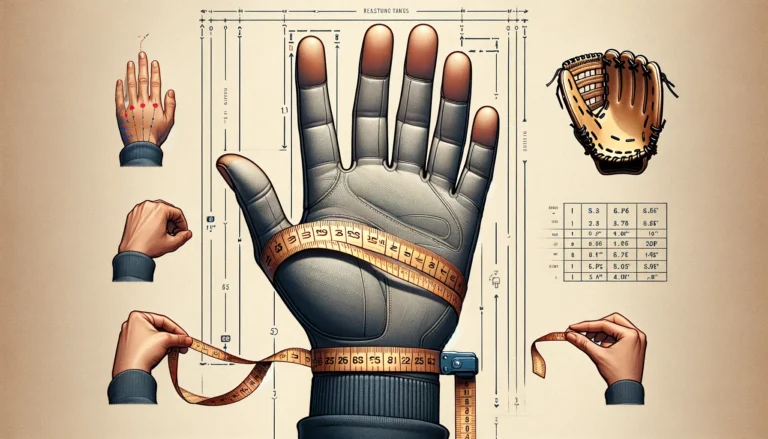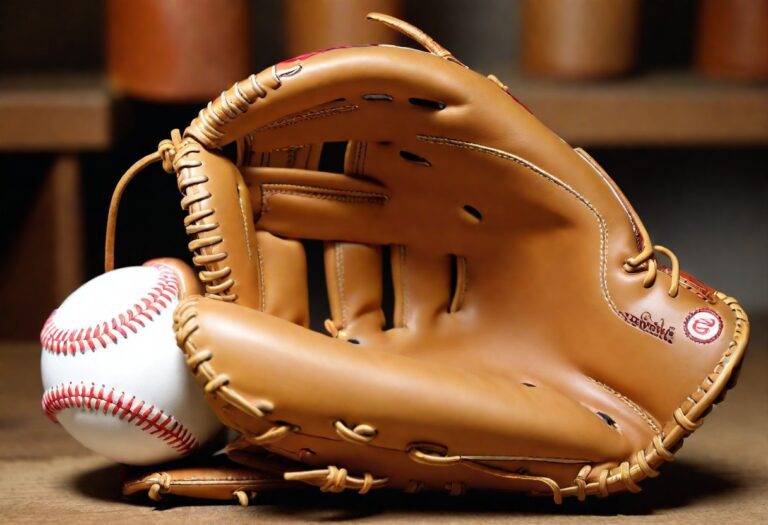How to Break in a Synthetic Baseball Glove?
Do you have a new synthetic baseball glove that’s stiff and hard to use? Breaking it in is essential for a better game experience.
Unlike leather gloves, synthetic ones need special care to get them game-ready.
In this article, we’ll guide you through simple steps to make your synthetic glove flexible and comfortable.
Whether you’re a seasoned player or just starting, our tips will help you get your glove in top shape, enhancing your performance on the field.
Key Takeaways
- Breaking in a synthetic glove is essential for flexibility and player confidence, especially for youth players who may quickly outgrow their gear.
- Customization of the glove through shaping and playing catch is crucial for a personal fit and maintaining the glove’s shape over time.
- Proper break-in techniques should be employed to avoid damaging the synthetic material, with the use of glove accessories being beneficial.
- Routine maintenance, including proper storage and care, extends the glove’s lifespan and ensures consistent performance.
- Advanced players should consider the type of webbing and professional break-in techniques to fine-tune their gloves for optimal fielding.
Understanding the Need for Breaking in Synthetic Gloves
Why New Gloves Need Attention
When you first get your hands on a new synthetic baseball glove, you’ll notice it feels quite rigid.
This stiffness isn’t a flaw; it’s a sign of quality craftsmanship designed to ensure durability and peak performance. However, this initial rigidity can be a barrier to optimal play, making it essential to break in your glove properly.
Breaking in a synthetic glove involves a careful process to ensure it conforms to your hand and playing style.
Here are some steps to consider:
- Gradually working the glove’s material to soften it without compromising its integrity.
- Flexing and bending the glove at its hinge points to promote flexibility.
- Using the glove in practice sessions to naturally shape it to your hand’s contours.
Remember, patience is key. Rushing the break-in process can lead to damage or a glove that doesn’t fit as well as it should.
Take the time to break in your new glove, correctly, and you’ll be rewarded with a perfect fit that enhances your game.
Youth Players and Glove Familiarity: Building Confidence
For young baseball enthusiasts, the right glove is a foundational tool that can significantly influence their development and enjoyment of the game.
Comfort is key; a glove that fits well and feels good can boost a young player’s confidence and encourage a lasting passion for baseball.
It’s essential to prioritize a glove that suits their current needs over one that may be more durable but less comfortable.
Involving youth players in choosing their gloves is crucial. They should feel empowered to select a glove that appeals to them, both in comfort and style.
This engagement can make a big difference in their eagerness to play and learn:
- Let them try on various gloves to find the perfect fit.
- Ensure the glove is not too large, as it can affect their performance and safety.
- Opt for a slightly larger glove to accommodate growth, but avoid one that is overly big.
Remember, the early years in baseball are formative. A glove that grows with the player, both in fit and familiarity, sets the stage for a positive and progressive break in a baseball’ journey.
Synthetic vs. Leather: Breaking in Different Materials
When it comes to breaking in a new baseball glove however, the material makes a significant difference.
Synthetic gloves are known for their ease of use right from the start, offering a lightweight option that’s particularly popular among youth players.
In contrast, leather gloves, such as those made from pigskin, cowhide, or kip leather, require more time and effort to break in but provide a more natural feel and greater durability.
- Synthetic Gloves: Ideal for beginners or as specialty practice gloves. They are less expensive and lightweight but may lack the durability and natural feel of leather.
- Leather Gloves: Offer a range of options from pre-softened cowhide to premium leathers. They are heavier and require a break-in period but are valued for their longevity and performance.
Choosing between synthetic and leather depends on personal preference, the player’s age, and the level of play.
While synthetic gloves might be the go-to for young beginners, players looking for a glove that will last and improve with use often opt for leather.
It’s important to consider the weight of the glove as well, as heavier gloves can lead to quicker fatigue during play.
Lastly, craftsmanship and the grade of leather are crucial factors that affect the glove’s overall quality and break-in process.
Read Also: How to Break in a Baseball Glove in the Oven
Customizing Your Glove for the Perfect Fit

Shaping Your Glove: A Personal Touch
Breaking in your synthetic baseball glove is not just about making it game-ready; it’s about molding it to the contours of your hand for that perfect fit.
The process demands a combination of thoughtfulness and patience. Begin by wearing the glove frequently, flexing and shaping it with your hand inside to encourage flexibility and comfort.
Here are some steps to personalize the shape of your glove:
- Wear the glove multiple times a day, focusing on flexing and manipulating the material.
- Use your hand to press and shape the glove, paying special attention to the pocket and finger areas.
- While the glove is still new, practice catching and throwing to help form the shape naturally through use.
Remember, the goal is to customize the glove to your hand’s unique shape, ensuring it becomes an extension of your body on the field.
Regular inspection for wear and tear, such as loose laces, and addressing these issues promptly can prolong the life of your glove.
By investing time in shaping your glove, you’ll be rewarded with a piece of equipment that feels like a natural extension of your hand.
The Role of Playing Catch in Glove Break-In
Playing catch is a fundamental part of breaking in a new synthetic baseball glove. It’s a method that not only helps soften the glove but also molds it to the shape of the palm of your hand for a custom fit.
Engaging in a game of catch allows for the glove to flex and move, simulating the conditions of an actual game and promoting a faster break-in process.
Here are some steps to effectively use playing catch in the break-in process:
- Start with gentle tosses to avoid overstraining the new material.
- Gradually increase the intensity and distance of the throws as the glove becomes more pliable.
- Focus on using the pocket of the glove to catch the ball, which will help form a natural cradle.
- Incorporate different types of catches, such as grounders and pop flies, to break in all areas of the glove.
Remember, consistency is key. Regularly playing catch will ensure that the glove conforms to your hand and playing style, making it an extension of your body on the field.
Additionally, avoid using the glove in actual games until it has reached an adequate level of flexibility and comfort.
Maintaining the Shape: Proper Glove Storage Techniques
Ensuring your synthetic baseball glove retains its shape is crucial for performance on the field.
Proper storage is key to maintaining the glove’s form and functionality. After each use, it’s important to clean the glove of any dirt or moisture to prevent material degradation.
Here are some steps to follow for effective glove storage:
- Place a baseball or softball inside the glove to help it hold its shape.
- Wrap the glove around the ball, using a glove wrap, elastic band, or a soft cloth to keep it secure.
- Store the glove in a cool, dry place, away from direct sunlight to avoid material warping.
Regular inspection of your glove for signs of wear, such as fraying laces, can prevent minor issues from becoming major problems.
Addressing these promptly ensures your glove remains in top condition for as long as possible. Remember, a well-maintained glove is a reliable tool on the field.
Read Also: How to Break in a Baseball Glove with Hot Water
Practical Break-In Techniques for Synthetic Gloves
The Dos and Don’ts of Softening Synthetic Gloves
When it comes to softening synthetic baseball gloves, a careful approach is key. Avoid the temptation to use quick-fix solutions like microwaving or soaking in warm water first, as these can damage the material. Instead, focus on methods that gradually work the glove’s fibers.
- Do start with a light application of glove conditioner to keep the material pliable.
- Don’t overdo it with oils or conditioners; a little goes a long way.
- Do use the glove in practice sessions to naturally work in the material.
- Don’t expose the glove to extreme temperatures or direct sunlight for prolonged periods.
Remember, using oil or conditioner by themselves won’t do much, but combined with other suitable break-in methods, they can be effective.
Patience is essential; allow your glove to break in overtime to ensure a perfect fit and optimal performance.
Using Glove Accessories for Efficient Break-In
Breaking in a synthetic baseball glove can be a streamlined process with the right accessories. Glove accessories such as glove oil, wraps, and mallets are essential tools for shaping and softening your first softball glove.
Here’s how to use them effectively:
- Start by applying a small amount of glove oil to the leather parts of your synthetic glove. This will help soften the material without oversaturating it.
- Use a glove mallet to mimic the impact of a baseball by gently pounding the pocket and breakpoints. This simulates catching and helps form the glove.
- After each break-in session, secure your glove with a glove wrap to maintain the desired shape and ensure that it conforms to your hand.
Remember, while accessories can aid in the break-in process, they should be used sparingly to avoid damaging the synthetic materials. Always refer to the manufacturer’s guidelines for the best results.
Avoiding Common Mistakes in Glove Care
Proper care of your synthetic baseball glove is essential to maintain its shape and performance.
Avoid exposing your glove to extreme temperatures, or hot, as this can cause the materials to deteriorate more quickly.
After each use, it’s important to clean your glove to remove dirt and moisture, which can lead to premature wear.
When storing your glove, consider the following tips to prevent common mistakes:
- Use a glove bag or wrap the glove in a soft cloth to protect against dust and scratches.
- Regularly inspect the glove for signs of wear, such as weakened laces, and repair them promptly.
- Avoid compressing the glove under heavy items, as this can deform its shape.
By following these simple steps, you can extend the life of your glove and ensure it remains a reliable part of your baseball gear.
Read Also: How to Break in a Baseball Glove with Shaving Cream
Ensuring Longevity and Performance
Routine Maintenance for Lasting Durability
To ensure your synthetic baseball glove stands the test of time, routine maintenance is key.
Regular cleaning of pro gloves is essential; after each use, wipe down your glove with a damp cloth to remove dirt and debris.
This not only keeps your glove looking great but also prevents the buildup of materials that can degrade the synthetic fibers over time.
Storing your glove properly is just as important as keeping it clean. Use a glove bag or wrap it in a soft cloth to protect it from dust and potential scratches.
Regular inspections for signs of wear, such as loose laces, can prevent minor issues from becoming major problems. Address these promptly to extend the life of your glove.
By following these simple steps, you can maintain the peak performance of your glove and enjoy a consistent, reliable game experience season after season.
When to Replace Your Glove: Signs of Wear and Tear
A well-maintained baseball glove can be a player’s best friend on the field, but even the best gloves have a lifespan.
Inspect your glove regularly for any signs that it’s time for a replacement.
Look for loose or weakened laces, which are often the first indicators of a glove nearing the end of its serviceable life.
Addressing these issues promptly can prevent them from escalating into more significant problems.
Another aspect to consider is the condition of the stitching. Strong, tight stitching is crucial for a glove’s durability.
If you notice fraying or loose stitches, especially around the pocket and fingers, it’s a clear sign that your glove may need to be retired. Additionally, check the lining of your glove.
Quality linings not only provide comfort but also affect how the glove breaks in and handles sweat.
Lastly, be mindful of how the glove feels during play. Comfort is key, and a glove that no longer fits well or feels right can hinder performance and even lead to injury.
Remember, youth players will outgrow their equipment, so it’s essential to balance durability with the need for a proper fit.
Expert Tips from Sporting Goods Professionals
Sporting goods professionals bring a wealth of knowledge when it comes to maintaining and enhancing the performance of your synthetic baseball glove.
They emphasize the importance of a personalized fit for maximum comfort and efficiency on the field.
- Always consult with a professional when selecting glove conditioning products to ensure they are suitable for synthetic materials.
- Regularly seek advice on the latest glove care techniques to keep your glove in top condition.
- Take advantage of professional glove-steaming services offered at many sporting goods stores to expedite the break-in process.
Remember, advice from seasoned professionals can be invaluable, especially when it comes to understanding the nuances of glove care that can make a significant difference in your game.
Read Also: What Oil to Use to Break in a Baseball Glove
Advanced Tips for Competitive Players

Fine-Tuning Your Glove for Optimal Fielding
Fine-tuning your glove for optimal fielding is essential for competitive players who demand precision and comfort during play.
Adjusting the fit of your glove can make a significant difference in your fielding abilities. A well-fitted glove acts as a natural extension of your hand, allowing for quicker reactions and smoother catches.
To achieve this perfect fit, consider the following steps:
- Ensure that the glove’s padding conforms to your hand’s shape without any uncomfortable pressure points.
- Adjust the tightness of the straps, such as the hook-and-loop fastener strap, to secure the glove snugly around your hand.
- Work the glove’s leather by flexing and bending it at key points to promote a more natural grip.
Remember, a glove that fits well not only improves your game but also reduces the risk of injury by providing better support and control.
Regularly inspect your own leather glove itself for any signs of wear and tear and address them promptly to maintain its condition.
Leveraging Professional Techniques for Glove Break-In
When it comes to breaking in a synthetic baseball glove properly, professional techniques can make all the difference. These methods are designed to ensure that your glove is game-ready without compromising its integrity or performance.
Here are some steps to follow:
- Start by gently working the glove with your hands, flexing the fingers and thumb to begin loosening the material.
- Use a specialized glove conditioner, applying it according to the manufacturer’s instructions to maintain the glove’s quality.
- Employ a glove mallet to simulate the impact of a baseball, which helps form the pocket and soften the glove’s fibers.
Remember, patience is key. Allow the glove to gradually conform to your hand and arm’s shape and playing style.
Avoid shortcuts that may damage the glove, such as excessive heat or improper substances.
Instead, focus on techniques that preserve the glove’s longevity, ensuring that it remains a reliable part of your gear for seasons to come.
The Impact of Glove Web Types on Performance
The web type of a baseball glove is a critical factor in performance, particularly for competitive players.
Different web designs cater to specific positions and playing styles, enhancing ball control and fielding efficiency.
For instance, infielders often prefer an I-web or H-web for their open design, which facilitates quick ball transfers and prevents dirt from hindering play.
Outfielders, on the other hand, may opt for a trapeze web or a modified trapeze web. These designs offer a deeper pocket and better visibility against the sun, crucial for tracking high flies.
Pitchers tend to choose closed webs like the basket weave, which helps conceal the ball and their grip from batters.
When selecting a glove, consider the following points:
- The open or closed nature of the web
- The depth of the pocket suited for your position
- The ease of transferring the ball to your throwing hand
Remember, the right web type can significantly impact your game, so choose wisely to ensure peak performance on the field.
Read Also: How to Clean the Inside of a Baseball Glove
Conclusion
In conclusion, making your synthetic baseball glove ready for the game is key to playing your best. Synthetic gloves are different from leather ones, so they need special care to get them just right.
Our guide has shown you how to do this step by step. It’s important to be patient. A glove that fits well not only makes the game more fun but also gets more comfortable every time you use it.
No matter if you’re just starting or you’ve been playing for years, putting in the effort to make your glove work for you is
Frequently Asked Questions
Do synthetic baseball gloves need to be broken in?
Yes, synthetic baseball gloves typically require breaking in to improve flexibility and create a custom fit for the player.
How can I break in my synthetic baseball glove quickly?
You can break in your synthetic glove by shaping it with your hands, playing catch regularly, and using glove accessories, such as a glove mallet or wrap, to help form the pocket and maintain its shape.
What are some common mistakes to avoid when breaking in a baseball glove?
Avoid using excessive heat, oils, or shaving cream, as these can damage the synthetic material. Also, don’t neglect routine maintenance and proper storage to preserve the glove’s shape and condition.
How do I know when it’s time to replace my baseball glove?
It’s time to replace your glove when it shows significant wear and tear, such as loose stitching, tears, or a lack of support that affects your performance on the field.
What’s the best way to maintain the shape of my synthetic baseball glove?
Maintaining the shape of your synthetic glove involves regular use, proper storage with a glove wrap or ball in the pocket, and avoiding exposure to extreme temperatures and moisture.
Are there any specific web types that impact the performance of a baseball glove?
Yes, the type of web on your glove can affect performance. Different web types offer varying levels of flexibility, support, and visibility, which can be advantageous depending on your position and personal preference.







